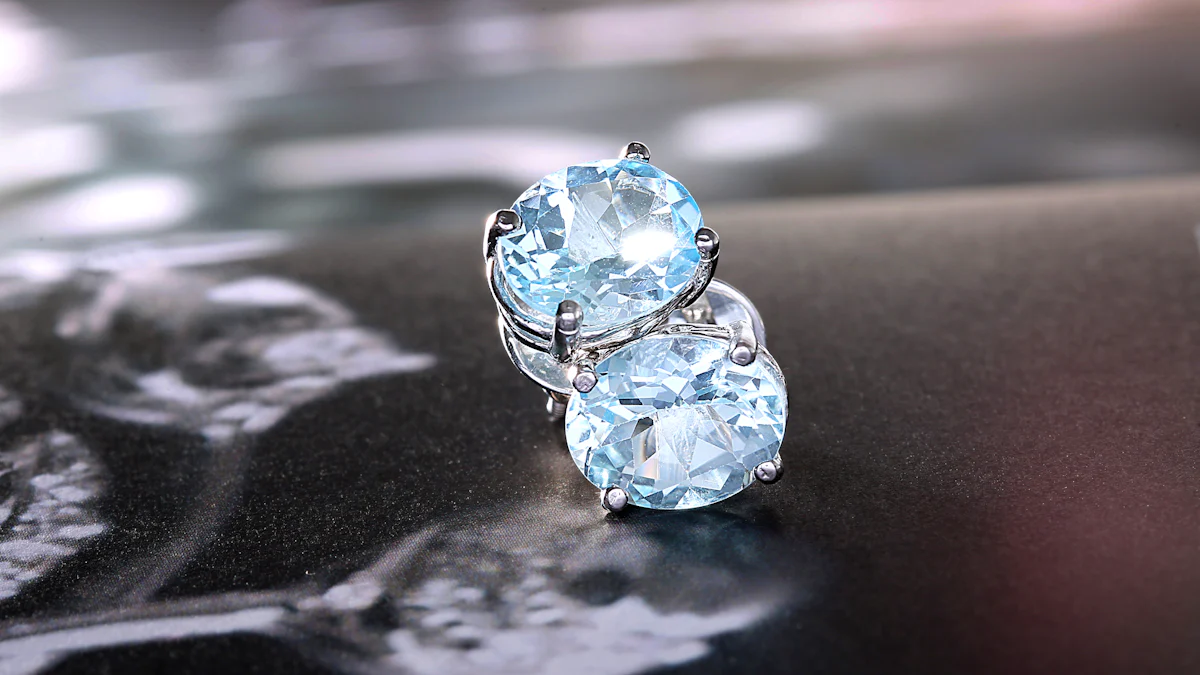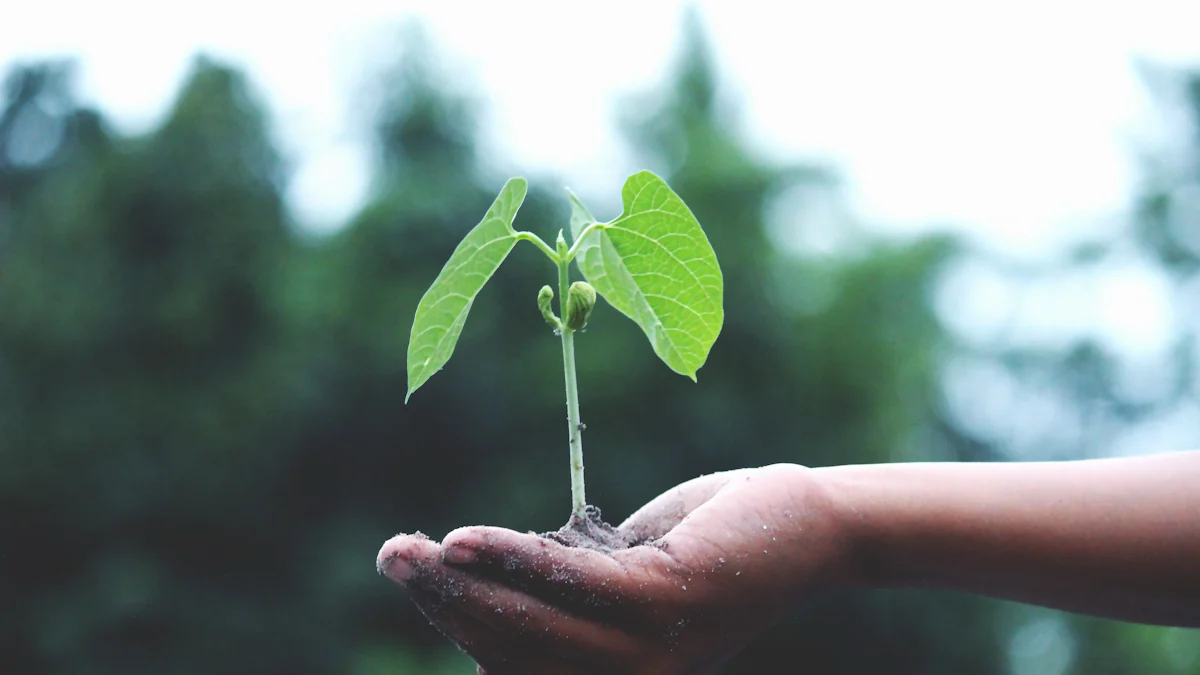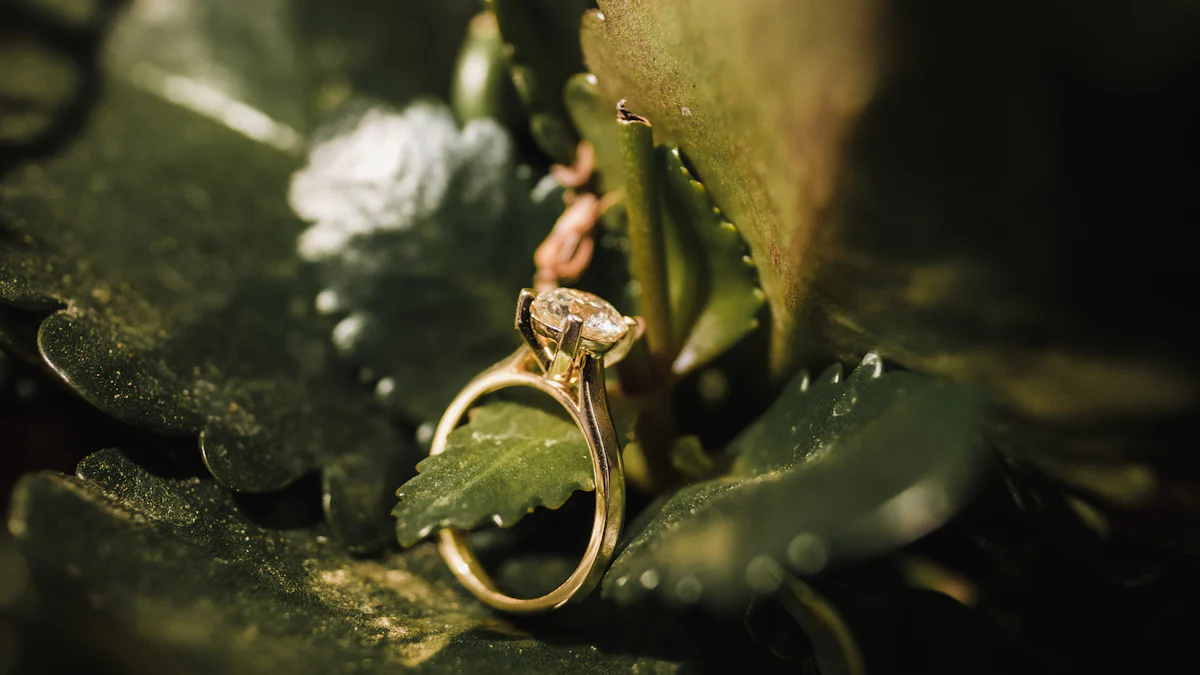Reviewing Certifications for Sustainable Diamonds

When you buy a diamond, you hold more than a sparkling gem—you hold a story. Certifications ensure that story reflects sustainability and ethics. Without them, diamonds may come from mines causing deforestation, soil erosion, or even polluted rivers harming communities. Some diamonds, known as conflict diamonds, fund violence in war zones. Thankfully, sustainable diamonds offer a better choice. Consumers like you are driving change, with 62% prioritizing sustainability for meaningful purchases. By choosing certified diamonds, you protect the planet and support ethical practices, making every purchase a step toward a brighter future.
Understanding Sustainable Diamonds

What Are Sustainable Diamonds?
Definition and characteristics.
Sustainable diamonds represent an ethical alternative to traditional mined diamonds. These diamonds prioritize responsible sourcing, ensuring that their journey from mine to market avoids environmental harm and human rights abuses. They also emphasize sustainability by minimizing their ecological footprint through practices like land reclamation, pollution control, and renewable energy use. Beyond environmental care, sustainable diamonds contribute to social responsibility by supporting fair wages, safe working conditions, and community development.
Key characteristics of sustainable diamonds include:
- Responsible sourcing throughout the supply chain.
- Reduced environmental impact through eco-friendly practices.
- Social responsibility, ensuring fair treatment and community engagement.
- Economic contributions, such as job creation and local investments.
Ethical and environmental concerns addressed.
Traditional diamond mining often disrupts ecosystems, generates mineral waste, and consumes significant water resources. Sustainable diamonds, especially lab-grown ones, offer a solution with a lower environmental impact. For example:
| Aspect | Sustainable Diamonds (Lab-Grown) | Traditional Diamonds (Mined) |
|---|---|---|
| Greenhouse Gas Emissions | Significantly lower | High |
| Energy Source | Renewable energy | Non-renewable |
| Land Disruption | Less | More |
| Mineral Waste Generation | Less | More |
| Water Usage | Lower | Higher |
By choosing sustainable diamonds, you help reduce greenhouse gas emissions, conserve water, and protect wildlife habitats. These diamonds also ensure ethical practices, preventing conflict funding and promoting transparency in the diamond industry.
Benefits of Sustainable Diamonds
Reducing environmental harm.
The benefits of sustainable diamonds extend beyond their beauty. Companies producing these diamonds aim for a net-zero carbon footprint by improving energy efficiency and investing in renewable energy. Water recycling practices in mining operations further reduce water consumption and pollution. Over time, the diamond industry has committed to decreasing water usage significantly, ensuring a more sustainable future. Some companies even transform previously exploited mining areas into thriving ecosystems, creating a positive environmental legacy.
Promoting ethical practices in the diamond industry.
Sustainable diamonds promote ethical practices by prioritizing transparency and responsibility. Every purchase supports a diamond industry that values fair treatment, safe working conditions, and community development. These diamonds ensure that mining does not contribute to conflict or human rights abuses. By choosing certified sustainable diamonds, you empower local communities and foster long-term development. Your decision creates a ripple effect, encouraging the industry to adopt more ethical and sustainable practices.
Key Certifications for Sustainable Diamonds
Overview of Major Certifications
SCS-007 Standard for Sustainability Rated Diamonds
The SCS-007 certification sets the gold standard for sustainable diamonds. It evaluates both lab-grown and mined diamonds based on rigorous environmental, social, and governance (ESG) benchmarks. This certification ensures a net zero carbon footprint and sustainable production practices. By choosing diamonds with this certification, you support ethical alternatives that prioritize transparency and sustainability.
Kimberley Process Certification Scheme
The Kimberley Process Certification Scheme (KPCS) plays a vital role in eliminating conflict diamonds from the global market. It requires rough diamonds to carry a government-issued certificate confirming they are conflict-free. This initiative has significantly reduced the trade of conflict diamonds, ensuring that your purchase supports responsible sourcing.
Responsible Jewellery Council (RJC) Certification
The Responsible Jewellery Council (RJC) certification promotes ethical, social, and environmental practices across the jewelry supply chain. It validates a company’s commitment to transparency and integrity, giving you confidence in your choice. RJC-certified companies often lead the industry in sustainability efforts, making them a trusted source for sustainable diamonds.
How Certifications Ensure Sustainability
Standards and criteria for certification
Certifications rely on strict criteria to evaluate sustainability. These include:
| Pillar of Sustainability Achievement | Description |
|---|---|
| Verified origin traceability | Ensures diamonds can be traced back to their source. |
| Twelve principles of ethical stewardship | Adheres to major ethical standards in diamond production. |
| Verified Net Zero Carbon Footprint | Commits to reducing carbon emissions to net zero. |
| Sustainable production practices | Implements environmentally friendly production methods. |
| Sustainability investments | Supports projects that benefit communities and the environment. |
These standards ensure that certified diamonds meet the highest levels of environmental and ethical responsibility.
Verification processes and transparency
Certifications use robust verification processes to maintain transparency. For example:
- The Kimberley Process ensures diamonds are conflict-free.
- The RJC evaluates ethical, social, and environmental practices.
- The Gemological Institute of America (GIA) provides unbiased grading reports.
- Fair Trade Certification focuses on fair labor practices and environmental sustainability.
These processes include enhanced security, accurate traceability, and fraud prevention, giving you confidence in the authenticity of your diamond.
Comparing Certifications
Unique features of each certification
Each certification offers unique benefits:
| Unique Features of SCS-007 Standard | Description |
|---|---|
| Stringent ESG Achievement | Focuses on environmental, social, and governance factors |
| Net Zero Carbon Footprint | Commitment to climate neutrality |
| Sustainable Production Practices | Ensures minimal environmental impact |
| Comprehensive Origin Traceability | Guarantees source-to-market certainty |
| Investments in Vulnerable Communities | Supports community development and safety initiatives |
Strengths and limitations
While certifications like the RJC enhance credibility and provide valuable resources, they may not always guarantee complete traceability. The Kimberley Process has reduced conflict diamonds but does not address broader environmental concerns. Understanding these strengths and limitations helps you make informed decisions when selecting sustainable diamonds.
The Role of Lab-Grown and Recycled Diamonds

Lab-Grown Diamonds
Creation process and sustainability.
Lab-grown diamonds are created in controlled environments using advanced technology that replicates the natural diamond formation process. These diamonds are grown either through High-Pressure High-Temperature (HPHT) or Chemical Vapor Deposition (CVD) methods. While they eliminate the need for mining, their production still has an impact on the environment. For instance, producing one polished carat of lab-grown diamond releases approximately 511 kg of greenhouse gases. Additionally:
- Lab-grown diamonds require significant electricity, water, and chemicals.
- Over 60% of production occurs in regions reliant on coal, increasing their carbon footprint.
Despite these challenges, sustainable lab grown diamonds remain a better alternative to mined diamonds when produced using renewable energy sources. They reduce land disruption and avoid the ethical issues tied to traditional mining.
Certifications applicable to lab-grown diamonds.
Certifications ensure the quality and sustainability of lab-grown diamonds. Some key certifications include:
- IGI Certification: Offers specific grades for color and clarity.
- GIA Certification: Provides a Laboratory Grown Diamond Report for identity and quality assurance.
- AGS Certification: Resumes grading lab-grown diamonds with unique cut and clarity standards.
- SCS-007 Certification: Focuses on sustainability standards, ensuring a net zero carbon footprint.
Recycled Diamonds
Definition and significance.
Recycled diamonds, also known as reclaimed or repurposed diamonds, are pre-owned stones reintroduced into the market. They do not require new mining or manufacturing, making them an eco-friendly choice. By choosing recycled diamonds, you help reduce deforestation, habitat destruction, and water consumption. This option also avoids the energy-intensive processes involved in creating lab-grown diamonds, further minimizing carbon emissions.
Certification standards for recycled diamonds.
Certifications for recycled diamonds ensure transparency and sustainability. For example:
| Aspect | Description |
|---|---|
| Certification Standard | SCS-007 Certification Standard for Sustainability Rated Diamonds |
| Applicability | Applies to both natural and laboratory-grown diamonds |
| Focus | Emphasizes sustainability, including environmental, social, and governance (ESG) criteria |
| Origin Traceability | Provides unparalleled transparency and assurance of diamond origin traceability |
| Carbon Footprint | Incorporates metrics to achieve a net zero carbon footprint |
| Community Support | Investments that support vulnerable communities and reduce impacts |
Benefits of Sustainable Diamonds in Lab-Grown and Recycled Options
Environmental advantages.
Lab-grown and recycled diamonds offer significant environmental benefits. Recycled diamonds avoid new mining, conserving resources and reducing pollution. They also eliminate the need for energy-intensive manufacturing. Lab-grown diamonds use less water and emit fewer greenhouse gases compared to mined diamonds. However, their energy consumption can be substantial, especially when sourced from non-renewable energy. By choosing these options, you contribute to sustainability and reduce the diamond industry's overall impact on the environment.
Addressing ethical concerns.
Both lab-grown and recycled diamonds address ethical issues in the diamond industry. Lab-grown diamonds are conflict-free, produced in controlled environments that eliminate human rights abuses. Recycled diamonds, on the other hand, avoid new mining, reducing exploitation and supporting fair practices. These options empower you to make ethical choices while enjoying the beauty of diamonds without compromise.
How to Identify Certified Sustainable Diamonds
Tips for Consumers
Recognizing certification labels and documentation.
When buying ethical diamonds, recognizing certification labels is essential. Certifications like GIA, HRD, and IGI provide reliable assurance of a diamond's quality and ethical sourcing. Here's a quick guide to help you identify trusted certification labels:
| Certification Laboratory | Description | Reliability |
|---|---|---|
| GIA | Known for reliability and accuracy in grading reports. | High |
| HRD | Widely trusted in the European market. | High |
| IGI | Offers comprehensive certifications accepted in the trade. | High |
| GSI | Recognized for reliable certifications with faster turnaround. | Moderate |
| IIDGR | Aligns with international standards, trusted in India. | High |
| Forevermark | Focuses on ethically sourced diamonds with unique inscriptions. | High |
Look for these labels on diamond documentation to ensure you're purchasing certified sustainable diamonds.
Researching certification bodies.
Understanding the certification body behind your diamond is equally important. Reliable organizations uphold strict sustainability standards. Here's what to look for:
| Sustainability Factor | Description |
|---|---|
| Verified origin traceability | Ensures the diamond's source is documented and can be traced back. |
| Twelve principles of ethical stewardship | Covers environmental, social, and governance (ESG) aspects. |
| Verified climate neutrality | Confirms that the diamond's production has a net zero carbon footprint. |
| Sustainable production practices | Involves methods that minimize environmental impact during production. |
| Sustainability investments | Supports vulnerable communities and contributes to a safer world. |
Researching these factors helps you choose diamonds from organizations committed to sourcing materials ethically.
Questions to Ask Jewelers
Verifying diamond sources and certifications.
When speaking with jewelers, ask direct questions about the diamond's origin and certification. For example:
- "Can you provide documentation verifying the diamond's certification?"
- "What steps do you take to ensure your diamonds are conflict-free?"
These questions help you confirm the authenticity of the diamond and its ethical sourcing.
Understanding sustainability commitments.
A jeweler's commitment to sustainability reflects their values. To assess this, consider the following steps:
- Investigate the jeweler's history and practices to understand their ethical stance.
- Look for brands that provide transparency about their supply chains.
- Assess the social impact of the brand in the communities where their materials are sourced.
By asking these questions, you can ensure your purchase aligns with your values.
Making Informed Choices
Balancing sustainability with personal preferences.
Choosing sustainable diamonds doesn't mean compromising on style or quality. Many consumers prioritize sustainability for significant occasions, with 62% willing to pay more for diamonds with sustainability credentials. Consider your budget and preferences while supporting ethical practices.
Supporting ethical and transparent brands.
Supporting brands that champion sustainability makes a difference. Companies like United By Blue and Cotopaxi lead by example, promoting transparency and ethical practices. By choosing such brands, you contribute to a better future while enjoying the beauty of ethical diamonds.
Certifications play a vital role in transforming the diamond industry. They ensure ethical sourcing, promote climate-neutral practices, and provide transparency, empowering you to make informed choices. By choosing sustainable diamonds, you support water recycling, wildlife preservation, and fair treatment of workers. These diamonds also uplift communities through job creation and investments in education. Your decision reflects care for the planet and society. Every certified diamond you select contributes to a future where beauty and responsibility coexist. Choose wisely, and let your purchase tell a story of love and sustainability.
FAQ
What makes a diamond "sustainable"?
A sustainable diamond minimizes environmental harm and supports ethical practices. It avoids conflict funding, reduces carbon emissions, and ensures fair labor. Certified sustainable diamonds meet strict standards for transparency, traceability, and eco-friendly production.
Are lab-grown diamonds better for the environment?
Yes! Lab-grown diamonds avoid mining, reducing land disruption and water usage. When produced with renewable energy, they emit fewer greenhouse gases. However, energy consumption remains a concern, so choose certified options for the most sustainable choice.
How can I verify if a diamond is conflict-free?
Look for certifications like the Kimberley Process or RJC. These ensure the diamond's origin is conflict-free. Ask your jeweler for documentation and traceability details to confirm ethical sourcing.
Why should I choose recycled diamonds?
Recycled diamonds eliminate the need for new mining, conserving resources and reducing pollution. They also avoid energy-intensive manufacturing, making them an eco-friendly and ethical choice without compromising quality or beauty.
Do certifications guarantee sustainability?
Certifications ensure diamonds meet strict ethical and environmental standards. While no system is perfect, certifications like SCS-007 and RJC provide transparency and accountability. They empower you to make informed, responsible purchases.
See Also
A Guide To Diamond Cuts For Engagement Rings
15 Best Eco-Friendly Gold Jewelry Brands This Year
An In-Depth Review Of Kay Jewelers Diamond Rings

